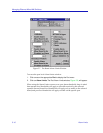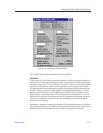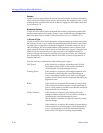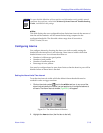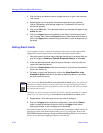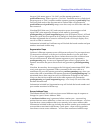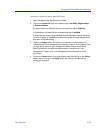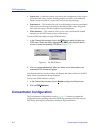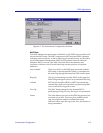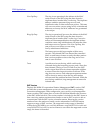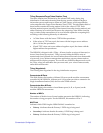
Managing Ethernet MicroLAN Switches
5-24 Trap Selection
A sourceAddressTimeout trap is issued anytime a source address is aged out of
the Source Address Table due to inactivity. The trapÕs interesting information
includes the module and port index, and the source address that timed out.
PortTypeChanged traps are issued when a portÕs topology status changes from
station to trunk, or vice versa. The interesting information includes the module
and port index, and the portÕs new topology status.
A lockStatusChanged trap is generated when the ports in the hub are locked or
unlocked using the Lock/Unlock Ports option on the Repeater menus; the
interesting information is the new lock status.
PortSecurityViolation and portViolationReset traps are sent in response to
changes related to port locking: if ports are locked, the portSecurityViolation trap
indicates that a new source address has attempted access on one of the ports, and
the ports are being shut down in response; the interesting information is the
module and port index, and the violating address. PortViolationReset traps are
sent when management intervention has re-enabled a port or ports previously
disabled in response to a port security violation; the interesting information is
module and port index.
Configuring Traps
The current status (enabled or disabled) for Link State, Segmentation, and Source
Address traps will always be displayed in the port-level Trap Selection window.
The repeater- and board-level windows will display current settings if they are
uniform; where settings are not uniform at the selected level, the corresponding
check box will be gray.
When you conÞgure traps, keep in mind the hierarchy of levels at which you are
setting traps; for the Ethernet MicroLAN Switch, traps set at the repeater or board
level will override current port-level settings for all ports on that repeater
channel.
NOTE
Some older repeater devices, and devices with older versions of Þrmware may include a
slightly different deÞnition of station and trunk status: station ports are deÞned as those
receiving packets from zero or one source addresses; trunk ports are deÞned as those
receiving packets from two or more source addresses. If you have any questions about
whether your device or Þrmware version falls into this older category, or if you would like
information about upgrading your device Þrmware, contact the Cabletron Systems Global
Call Center.
TIP
When you are setting repeater- or module-level traps, we recommend that you leave the
gray ÒNo SETÓ status untouched (especially for Source Addressing Traps) unless you are
sure you want to override port-level settings. With no incoming traps to inform you of a
port security violation, you may have ports that are disabled on your device for no obvious
reason.



